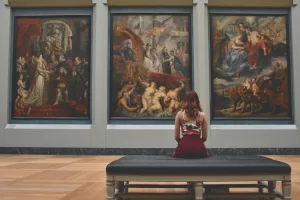Expressionism and Impressionism are two major artistic movements that have significantly influenced the world of art and music. These movements emerged during the 19th and 20th centuries, each with its own unique characteristics and approaches. Expressionism is a movement that focuses on expressing emotional experiences and perceptions rather than objective reality. Artists and musicians associated with Expressionism often use bold colors, exaggerated forms, and distorted compositions to convey intense feelings and inner thoughts. Expressionism is characterized by a sense of emotional turmoil, introspection, and subjectivity. This movement prioritizes the artist’s interpretation of the world, aiming to evoke powerful emotional responses from the audience. Expressionist artists often sought to challenge traditional artistic norms and explore new ways of representing the human experience. They rejected realistic depictions in favor of expressing inner emotions, dreams, and visions through their work. This emphasis on the internal world set Expressionism apart from other artistic movements of the time. In contrast, Impressionism seeks to capture fleeting moments and impressions of the world in a more spontaneous and observational manner. Impressionist artists and musicians focus on light, color, and atmosphere, aiming to depict the sensory experience of a scene rather than its precise details. Impressionism emerged as a reaction against the academic art traditions of the time, which emphasized meticulous detail and historical or mythological subject matter. Impressionists instead turned their attention to everyday scenes and landscapes, seeking to capture the essence of a moment with vibrant brushwork and a fresh perspective. The Impressionist movement was characterized by a desire to paint outdoors, or en plein air, to accurately capture the effects of natural light on a scene. Artists like Claude Monet and Pierre-Auguste Renoir embraced this approach, producing works that shimmered with life and movement, depicting the play of light and color in their surroundings.
Historical Context
Expressionism in Historical Context
Expressionism arose during a time of significant social, political, and psychological upheaval. Emerging in the early 20th century, particularly in Germany, it was a response to the anxiety and instability of the period. The industrial revolution, rapid urbanization, and the looming threat of war contributed to a sense of alienation and existential dread. Expressionist artists, such as Edvard Munch and Egon Schiele, used their work to confront these harsh realities, reflecting the chaos and emotional intensity of their time.
Impressionism in Historical Context
Impressionism, on the other hand, developed in the late 19th century, primarily in France. It was a period marked by optimism and innovation, with the advent of new technologies and a growing middle class. Impressionists like Monet and Degas were inspired by the changing urban landscapes and the vibrancy of modern life. They sought to capture the beauty and dynamism of their rapidly transforming environment, often focusing on leisure activities and the natural world.
Key Characteristics
Expressionism’s Key Characteristics
- Emotional Intensity: Expressionist works are known for their emotional depth, often exploring themes of fear, love, and despair. This emotional intensity is conveyed through dramatic use of color and form.
- Distorted Reality: Expressionists often distorted reality to emphasize emotion. This could involve exaggerated features in portraits or abstract representations of landscapes.
- Symbolism: Many Expressionist pieces are rich in symbolism, using visual metaphors to convey complex emotional states.
- Bold Colors: The use of vivid, often clashing colors is a hallmark of Expressionist art, serving to heighten emotional impact.
Impressionism’s Key Characteristics
- Light and Color: Impressionists focused on capturing the effects of light on color. This often meant painting the same scene at different times of day to observe subtle changes.
- Loose Brushwork: Impressionist paintings are characterized by loose, visible brush strokes that convey movement and spontaneity.
- Ordinary Subjects: Unlike the grand historical or mythological subjects of previous art movements, Impressionists often depicted everyday scenes and people.
- Atmosphere and Mood: By focusing on the play of light and shadow, Impressionists conveyed the atmosphere and mood of a scene, inviting viewers to experience the moment.
Techniques and Innovations
Techniques in Expressionism
Expressionist artists employed several innovative techniques to convey their intense emotions:
- Thick Application of Paint: Known as impasto, this technique involves applying paint thickly so that brush or palette knife marks are visible. This adds texture and dimension to the work, enhancing its emotional impact.
- Unconventional Materials: Some Expressionists experimented with unconventional materials and mixed media to add depth and complexity to their compositions.
- Dynamic Compositions: By using unusual angles and perspectives, Expressionists created a sense of movement and tension, drawing the viewer into the emotional world of the artwork.
Techniques in Impressionism
Impressionist techniques were revolutionary in their simplicity and focus on light:
- En Plein Air Painting: Many Impressionists painted outdoors to capture the natural light and its effects on the scene. This approach required quick, spontaneous brushwork to keep up with the changing light conditions.
- Broken Color Technique: Rather than blending colors on the palette, Impressionists often applied colors side by side, allowing the viewer’s eye to mix them. This technique enhanced the vibrancy and luminosity of their works.
- Focus on Movement: Impressionists often depicted scenes of movement, such as people walking or water flowing, using quick, fluid brushstrokes to convey the sense of motion.
Case Studies: Notable Works
Expressionism Case Study: “The Scream” by Edvard Munch
One of the most famous Expressionist works is “The Scream” by Edvard Munch. This iconic piece captures a moment of intense psychological distress, with swirling colors and distorted forms conveying a sense of panic and existential dread. The painting’s stark emotional impact has made it a timeless representation of human anxiety.
Impressionism Case Study: “Impression, Sunrise” by Claude Monet
Monet’s “Impression, Sunrise” is a quintessential example of Impressionism. Painted en plein air, it captures the port of Le Havre at sunrise with loose brushstrokes and a focus on the play of light on water. This painting gave the Impressionist movement its name and exemplifies the emphasis on capturing fleeting moments.
Common Mistakes and Misconceptions
Understanding the nuances between these two movements can be tricky. Here are some common misconceptions:
- Confusing Emotional Focus: Some might mistake the emotional depth of Impressionist works with that of Expressionism. While Impressionists convey mood, their primary focus is on light and color, not deep psychological states.
- Technical Overlap: Both movements use vibrant colors, but for different purposes. Impressionists use color to capture light and atmosphere, while Expressionists use it to evoke emotion.
- Historical Context: It’s easy to forget the distinct historical contexts that shaped these movements. Remembering the social and political influences can deepen your understanding of each movement’s objectives.
Impact on Later Movements
Expressionism’s Influence
Expressionism paved the way for later abstract and avant-garde movements. Its emphasis on individual perception and emotion influenced Abstract Expressionists like Jackson Pollock, who explored the subconscious through abstract forms.
Impressionism’s Influence
Impressionism’s focus on light and color had a profound impact on later movements such as Post-Impressionism and Fauvism. Artists like Vincent van Gogh and Henri Matisse drew inspiration from the Impressionists’ innovative use of color and form.
Practical Tips for Appreciating These Movements
For those looking to deepen their appreciation of Expressionism and Impressionism, consider these practical tips:
- Visit Museums and Galleries: Viewing these artworks in person allows you to see the texture, color, and brushwork up close, offering a richer understanding of each piece.
- Explore Different Mediums: Both movements influenced not just painting but also music, theatre, and literature. Explore works in these mediums to gain a broader perspective.
- Engage with Art Commentary: Reading critiques and analyses can provide valuable insights into the techniques and themes of these movements.
Conclusion: A Rich Tapestry of Artistic Innovation
Expressionism and Impressionism represent two distinct yet equally groundbreaking approaches to art and music. While Expressionism delves into the emotional and psychological realms, Impressionism captures the ephemeral beauty of the world. Together, they enrich our understanding of human experience and continue to inspire artists and audiences alike. By exploring the nuances of these movements, we can appreciate the diverse ways in which artists seek to convey the complexities of life.




